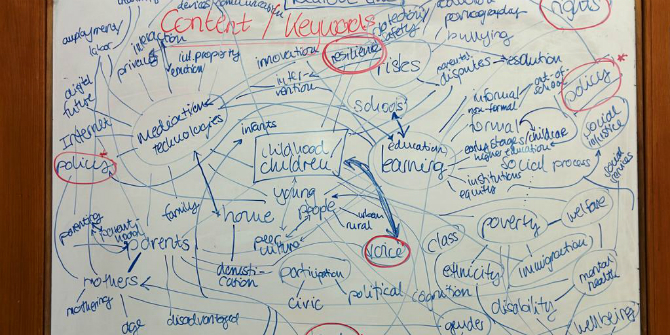 While it is important to highlight the risks which the internet may pose to children, a balance must be struck when it comes to online safety which acknowledges the many benefits and opportunities the internet offers. In this post, Colin Green outlines how the UK Council for Child Internet Safety’s (UKCCIS) Educating Children for a Connected World framework may help in teaching children how to use the internet with respect and responsibility, and the critical role that schools have to play in developing online safety education. Colin Green is the Director of Education at New Era of Education a company that provides cloud solutions and services for the education sector. He was a primary school teacher for twenty-six years and recently trained as a CEOP Ambassador.
While it is important to highlight the risks which the internet may pose to children, a balance must be struck when it comes to online safety which acknowledges the many benefits and opportunities the internet offers. In this post, Colin Green outlines how the UK Council for Child Internet Safety’s (UKCCIS) Educating Children for a Connected World framework may help in teaching children how to use the internet with respect and responsibility, and the critical role that schools have to play in developing online safety education. Colin Green is the Director of Education at New Era of Education a company that provides cloud solutions and services for the education sector. He was a primary school teacher for twenty-six years and recently trained as a CEOP Ambassador.
Online safety in schools
Online safety is an area of key concern for policy-makers, schools and parents in equal measure. It is important however that it is placed in context. As stated in the government’s green paper the internet has transformed the world. It is a powerful force for good and brings significant benefits.
To present the internet merely as a dangerous place, to put the potential harms at the forefront of learning would be as inappropriate as it would be ineffective. If we promote to children the dangers and potential risks in isolation from the benefits they will do one of three things: ignore the message; be fearful and reluctant users of the internet; or actively seek out the risks as an exciting challenge.
Children must be taught the benefits of the internet first and foremost, but also to use it with respect and responsibility. They need to engage with the internet, find it interesting, fun and exciting. Consequently, they need to develop an appropriate set of skills and understanding through developing digital citizenship. This may be achieved by adopting the UK Council for Child Internet Safety’s Educating Children for a Connected World framework alongside real opportunities to engage online.
The internet is increasingly being used by younger children
This learning needs to begin at an early age. Children are now accessing the internet in the early years prior to starting school. They are developing their knowledge and skills from their parents and older siblings. Evidence shows they are doing so at an increasingly younger age.
The risks have changed
Whilst many children may develop a good range of digital skills through this route, it leaves them unprepared for the risks. This is an area in which many adults, teachers and parents alike, are lacking both in terms of confidence and competence. Not only is it an area in which their own knowledge may be limited but it is also an area where our knowledge of the risks is developing at a pace.
A few years ago, most people would have identified cyberbullying, violent or pornographic content and grooming as the key areas of risk. How many however, would have considered fake news, profiling, sexting, radicalisation or the datafication of children as concerns or potential risks?
The UKCCIS framework begins to address these areas, but further development may be required as our understanding changes over time. The framework is the first real attempt to provide guidance across the spectrum of issues considered as central to developing digital citizenship. There have been previous resources that have covered specific areas well, but none with the depth and variety of topics as this one. From copyright to privacy, identity and self-image to health and wellbeing, the framework provides a structured approach to learning that can readily blend understanding in the offline and online worlds. It offers a coherent set of ‘can do’ steps to developing understanding in children and young adults, from app permissions to recognising fake news and propaganda. Most importantly it enables schools to teach children to take some active steps in developing their resilience in a rapidly-changing world.
This combination of early development of skills, the intuitive nature of devices, persuasive design, and growing and easy access means that we must proactively teach children about the benefits and potential harms of the internet hand-in-hand, through a systematic approach. Parents have a key role in this, but we cannot leave them to do it on their own. Schools must take a lead.
The challenge for schools
This is challenging for schools where curriculum change is invariably slow and painstaking, where teachers’ knowledge is variable and where the curriculum is already considered to be overcrowded.
The national curriculum requires schools to teach online safety. They have done so in the present format since 2014. This is a statutory requirement for maintained schools and a benchmark for academies. And yet, this still falls short. The emphasis on coding when the curriculum was introduced in 2014 undoubtedly had a negative impact on other aspects of the subject. Relationships (and sex) education will be statutory from September 2020 – likely containing a strand on online relationships. Furthermore, there are calls for statutory Personal, Social, Health and Economic education (PSHE). The confusion and lack of clarity in this space detracts from a clear approach to digital citizenship.
For many years now there have been calls for a coherent curriculum from age 4-18 covering digital citizenship, often presented as online safety or digital literacy. Such a curriculum, supported by parental involvement, is an essential ingredient of preparing our youngsters for the present and the future.
There are many PSHE schemes that can be simply and quickly adapted to ensure there is a digital extension for all the concepts covered. This doesn’t require a separate strand, but acknowledgement of the digital dimension in relationships, privacy, respect, information and so on.
The Education for a Connected World framework provides a ready-made structure; and it is a very good one. It provides a set of age-appropriate and progressive ‘can-do’ statements from age 4-18, across eight strands. It deals with the issue positively, recognising how young people interact with the internet and most importantly it empowers them from an early age. Furthermore it provides a continuum between the offline and online worlds. This gives teachers considerable guidance and it will shortly be supported by a range of resources. This is a coherent starting point for many schools that need to develop their curriculum. Inevitably it will need to be adapted over time.
Recognising the increasingly blurred boundaries between the offline and online worlds is critical. Not only does it provide a more comprehensive and realistic framework but also one that is much easier for schools to deliver in an increasingly crowded curriculum.
Whatever development takes place it will need to be supported by quality, on-going training for teachers who will need an approach that is flexible and adaptable. This is a critical aspect of meeting the challenges ahead. The rate of change impacts teachers’ knowledge and understanding as much as the rest of society.
Online activity should be at the core
Children will only develop the understanding required and embed appropriate attitudes if they have practical, guided and modelled opportunities to learn in context. This means the curriculum must provide opportunities to gain first-hand experience in communicating online through using blogs, forum, wikis, chat and email. This will not only give them an opportunity to develop and embed their understanding but will also enable parental involvement in the process, extending the learning beyond the classroom boundaries.
Online activities should be supported by them taking place in a safe and secure environment but systems should not prevent effective teaching and learning. Such systems already exist; now is the time for schools to develop their curriculum and their teacher training to meet the needs and demands of the age of the internet and for them to support parents in their key safeguarding role.
This post gives the views of the authors and does not represent the position of the LSE Parenting for a Digital Future blog, nor of the London School of Economics and Political Science.





